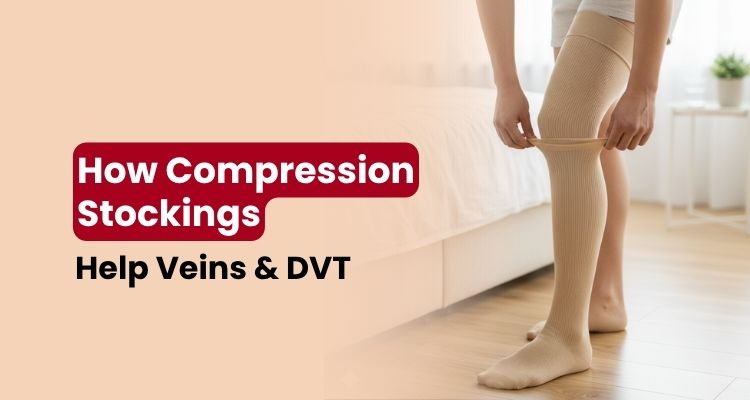No idea why doctors recommend using compression stockings to manage varicose veins or DVT? Those veins that return blood to your heart work hard each day and occasionally require a bit of extra support. Compression stockings lightly compress your legs to circulate blood more effectively, relieving the difficulties of varicose veins and deep vein thrombosis.
These specially crafted garments are more than just medical wear. They are your comfort and circulation companion every day. Interested in learning how compression stockings work and whether they are worth wearing? Let’s explore how compression stockings protect your veins and ensure improved leg health.
What are Compression Stockings?
Compression stockings (or compression socks) are elastic garments that should be worn snugly around the legs to help blood flow back toward the heart. They improve the blood flow and thus are a great remedy for pain, swelling, and other venous problems, including conditions such as DVT and chronic venous insufficiency as well. They are available in many pressure ratings measured in mmHg and may either be purchased over-the-counter or by prescription.
Compression stockings for DVT are made from durable, stretchable materials. Materials include nylon, spandex or cotton blends. They gently compress the surface arteries, veins, and muscles. This causes blood to move more easily through the veins and to the heart. This avoids blood pooling in the lower legs, which is the underlying cause of varicose veins and most venous conditions.
Types of Compression Stockings
1. Graduated Compression Stockings
Graduated compression stockings provide the maximum pressure at the ankle, decreasing progressively towards the top of the leg. This pressure gradient improves venous return and keeps blood from pooling in the leg. Doctors prescribe them routinely for the control of conditions like DVT, varicose veins, and postsurgical swelling.
2. Uniform Compression Stockings
Uniform compression stockings apply consistent pressure over the area covered. They are usually worn for comfort, preventing fatigue and muscle support during exercise. They are suitable for the person who requires normal leg support and not medical treatment.
3. Styles and Lengths
Compression stockings come in three different lengths, i.e., knee-high, thigh-high, and full pantyhose. The appropriate length depends on the disease that is being treated. Mild varicose veins can be treated with knee-highs, while severe venous conditions are best managed with thigh-high or pantyhose ones. Additionally, compression sleeves can be utilised by people who like open-toe garments or desire to have support without their feet being covered.
Who Should Use Compression Stockings?
Compression stockings are safe and useful for the majority of people. Many athletes wear compression stockings as a tool to speed up recovery and boost their performance. However, some people use them because of medical conditions. It is possible that you will find it helpful to put on a pair of compression stockings in case you:
- Suffer from varicose veins, spider veins, or venous insufficiency
- You are going through the recovery phase after a surgery or a long period of bed rest
- Suffer from swelling due to lymphedema
- Sit or stand for extended hours at work
- Often travel long distances by air
- Are pregnant and experience leg swelling
- Have diabetes or a history of venous disease in the family
- Engage in sports involving prolonged leg activity
Healthcare providers, at times, suggest compression therapy following some procedures like sclerotherapy or vein ablation to sustain the outcome and avoid recurrence.
Best Time to Wear Compression Stockings
Doctors usually advise wearing compression stockings in the morning before getting out of bed since legs are least swollen at this time. They must be worn during the day and taken off when going to bed. Using them in the morning prevents blood from pooling up in the veins upon arising from bed and engaging in daily activities.
Wearing them is somewhat difficult due to their tightness. The following tips make it easier to wear
- Get the stocking and reverse the toe portion inside out, place the foot in, and draw the material slowly up the leg.
- Add a little cornflour or baby powder for dry skin.
- Use rubber gloves for more grip.
- Smooth out your toenails and rough spots to avoid snags.
- Try a compression stocking donner, a device that keeps the stocking open to aid application.
Consistency is crucial in compression therapy. Regular use helps maintain venous pressure, and symptoms stay minimal.
Medical Advantages of Compression Stockings
1. Increased Blood Flow
External pressure applied by compression stockings assists the vein walls that make sure the flow of blood upwards is more efficient. Pooling is avoided, which eliminates the heaviness and swelling of the legs.
2. Symptom Relief of Varicose Veins
Varicose veins develop when vein valves do not work well, resulting in blood accumulation in the veins. Using compression stockings for varicose veins reduces pain, throbbing, and discomfort of this condition. They also enhance oxygen delivery to tissues, and this aids in faster recovery.
3. Prevention of Deep Vein Thrombosis (DVT)
DVT is the development of blood clots within deep veins, most commonly the legs. The risk for this is enhanced by prolonged immobility or surgery. Compression stockings promote continuous blood flow, reducing the possibility of clot development and its associated complications, such as pulmonary embolism.
4. Non-Invasive Option
Compression therapy for veins is a conservative management that does not involve surgery or drugs. It is safe, economical, and highly available. Most use it on a daily basis to control chronic venous disease comfortably.
5. Overall Vascular Health Support
Regular use makes vein walls stronger, lowers venous pressure, and slows the progression of existing conditions. Wearing compression stockings correctly supports vascular health in the long term and enhances comfort on a daily basis.
When to Consult a Varicose Vein Specialist?
Definitely, the first thing to do is to consult a healthcare provider. Proper treatment will then be guaranteed. There are some indications that suggest a professional evaluation is necessary:
- Leg pain that persists, swelling, or a feeling of heaviness, even if one is wearing compression stockings
- Discolouration, itching, and open sores can be seen around the affected veins
- If inflammation, redness, or bleeding is noticed around varicose veins
- Walking, sleeping, or doing daily activities with difficulty caused by leg pain
- Having a family history of venous insufficiency or frequent recurrence of varicose veins
- Worrying about possible complications like ulcers or thrombosis
- One of the major reasons would be the discontent with the exterior look of the veins that are bulging
A vascular specialist is able to do a Doppler ultrasound or venous mapping to find out the exact problem and recommend the right drug treatment, such as sclerotherapy, laser treatment or endovenous ablation.
Wrapping Up
Your life cannot be comfortable and active without healthy veins, and compression stockings have a major role in keeping them healthy. This medical wear improves blood circulation, relieves pain, and prevents the development of conditions such as varicose veins and deep vein thrombosis (DVT). Wearing them regularly and following the advice of your doctor will save you from vascular problems and be a great support for your legs’ health.
The best Interventional Radiologist in Mumbai, Dr. Kunal Arora, offers accurate diagnosis and less invasive treatment for vein diseases. His long-term experience in the treatment of varicose veins, DVT, and peripheral vascular diseases is your guarantee of a safe and effective therapy.
Visit Dr. Kunal Arora and get back your vein health and comfort!


